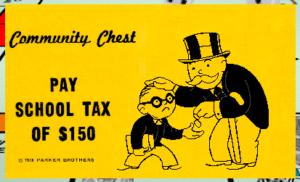 I got my real estate tax bill in the mail recently, and noted with horror that more than half of my annual chunk of flesh goes to my local school district. That chunk for schools got 16 percent bigger this year compared to last year, and on November 8th we’re being asked to vote yes for a bond and a “TRE” to make that wound permanent. As I finance guy, I like to understand why.
I got my real estate tax bill in the mail recently, and noted with horror that more than half of my annual chunk of flesh goes to my local school district. That chunk for schools got 16 percent bigger this year compared to last year, and on November 8th we’re being asked to vote yes for a bond and a “TRE” to make that wound permanent. As I finance guy, I like to understand why.
The immediate “why” dates back to a May 2016 ruling by the Texas Supreme Court that variously described the state public school finance system as Daedalean, Byzantine, Augean, and an “ossified regime ill-suited for 21st Century Texas.”
Clever classical references notwithstanding, the court also declined to intervene, found the system met “minimum constitutional requirements,” and referred future financing changes back to the state legislature. Immediately following that decision, school districts like my home district of San Antonio ISD began scrambling to find sources for much needed funding. Hence, my increased tax bill, and the ballot question to ratify that increased bill.
 Residents in the San Antonio ISD residential area – like me – are asked to vote November 8th for two increased funding items. The first is a run-of-the-mill $450 million bond vote, the proceeds of which are limited by law to capital improvements like renovations of school buildings.
Residents in the San Antonio ISD residential area – like me – are asked to vote November 8th for two increased funding items. The first is a run-of-the-mill $450 million bond vote, the proceeds of which are limited by law to capital improvements like renovations of school buildings.
The second vote, for a Tax Ratification Election – or TRE – is a bit more unusual and offered me a window into the weird world of public school financing. Since bond money proceeds can only be spent on buildings – the “hardware” of education – TRE money pays for for improvements in the “software” of education, such as educational programs.
The need for this particular TRE vote arises from the peculiar funding rules and history that govern public school finance in Texas.
History of funding
Both nationally and in Texas, we initially fund schools at the municipal and county tax level rather than at the state or national tax level. This results, naturally, in huge inequalities in school funding based on property tax and property value differences across cities and towns.
Next, at least in Texas, we sue the legislature over unequal funding levels, as happened in 1989 when Edgewood ISD along with others won a state Supreme Court case based on this inequality.
The state then created mechanisms for roughly equalizing the distribution of money, primarily through a state fund called the Foundation School Program (FSP.) Money for the FSP come from a combination of state allocations and funds recaptured from property-wealthy districts, such as I described in Houston ISD last week.
Even though the burden of funding still sits with locals, in 2006, the state legislature ratcheted downward the amount of tax that local districts could raise, from $1.50 to $1.00 per $100 in property tax value. For example, a $200,000 house taxed at $1.00 per $100 in tax value would generate $2,000 in school taxes, rather than the previous $3,000 in taxes at the $1.50 rate.
That would normally be great because – “Hey look! Lower taxes!” – but the state legislature realized subsequently that if local districts don’t tax enough, the state would have to make up the difference with the FSP (state money). So that had to be undone, or else we’d have to raise more state taxes. Also, in the case of Texas in particular, a statewide income tax or “Ad Valorum Tax” is unconstitutional, so taxing decisions have to be – or at least appear to be – made at the local rather than the state level.
Between the 2009 and 2013 legislatures, a system emerged to incentivize more local taxation, presumably to relieve the legislature from providing more funds at the state level. As local districts raise more revenue locally, approaching $1.17 per $100 of property value ($1.17 is the new state cap on local taxation) the state will match some of that money through the FSP.
And that increase in property tax to capture matching state funds for your local school district are what’s at stake on the ballot in San Antonio ISD, and where many other school districts in Texas will look to raise money in the future. The $0.13 bump on my ballot of $1.04 to $1.17 per $100 property value will increase taxes on a $200,000 home by $260 per year.
My school district hopes to ratify the tax raise to the tune of about $15.6 million from local taxpayers, with the promise of about $16.5 million in matching state funds from the FSP.
Is that clear? Or clear as mud? This kills me with how confusing it is.
Look, I’m pretty good at bond math, cash flows, and spreadsheets. I have watched live presentations on the bond and TRE question; I’ve watched multiple video presentations online; I’ve read the entire 100-page Supreme Court ruling from May 2016; and I’ve sat down for long one-on-one conversations with SAISD officials – and I still find this ballot question incredibly confusing.
By state law, I understand this has to be a ballot question for voters, but honestly, there is no way for informed citizens to actually understand and vote on this other than an unsophisticated choice between: “Public Schools (Good!)” or “Taxes (Bad!)”
And that’s upsetting to me. When an issue is as confusing as public school finance is in Texas, you should always ask yourself – who benefits from the complexity and who loses?
I complained about this complexity to Seth Rau, SAISD’s Legislative Coordinator, who assured me, depressingly, that Texas is right in the middle of the pack nationwide when it comes to school finance complexity. Rau joined SAISD in 2015 from Nevada – as did Superintendent Pedro Martinez – where school finance is just as confusing. According to Rau, 45 of 50 states have tried to settle school finance problems through lawsuits. So I guess we don’t have a monopoly on “Daedalean,” “Augean,” and “Byzantine” systems here in the Lone Star state.
Full disclosure: public school finance feels very personal for me, with two kids in San Antonio ISD. As a parent of a first grader and sixth grader, I pinball between frustration with and empathy towards my school district, which at times appears intent on undermining positive student outcomes and at other times seems like it’s doing God’s Work Here On Earth under near-wartime conditions.
A version of this post ran in the San Antonio Express News and Houston Chronicle.
Please see related posts
HISD Ballot question – What is Wealthy?
Post read (193) times.





One Reply to “School Finance And My Tax Bill”
My organization has a concise PowerPoint explanation of the school-finance system that I would be happy to email to you as an attachment. Please contact me at the email below